And Other Chloride Methods
by Various Researchers
Some photos of the Hudson process - by M
Hudson's annotated process - by Ron Talmage
August's Process - by August
HCl/H2O2 method - by Barry Carter
Make White Gold Powder - By Don Nance
Jim's Ozone Method - by Barry Carter
<http://www.asc-alchemy.com/patent.html>
- by NaKaula
Safety First!!
This work consists of strong acids! These acids emit corrosive and
toxic fumes. At
some point in the work, other toxic fumes are emitted. Wear protective
gear, rubber gloves, eye protection, etc.
I started my work in a heavily ventilated garage-like building. It soon
became apparent that the fumes were corroding
exposed metal in the building, despite the heavy ventilation. I moved
the work outdoors on a card table during
good weather to do this. Be aware of the wind direction! Stay upwind of
the work! I have had some experience in
working with strong acids in chemistry classes, so I felt confident of
my safety precautions and knowledge of how
to handle these caustic acids. This is not for the chemically
inexperienced! I cannot be responsible for any harm
that may come to you if you try this.
Use no metal!!! No metal pots, spoons, stirrers.... nothing metal touches the work! Pots shall be glass. Spoons or stirrers should be glass or 'Teflon' (HDPE) or other acid-resisting nonconductive material. I used one of the golden tan Corning Pyrex saucepans. It has a nice pouring lip, and a glass cover. The pouring lip will still allow fumes and steam to escape even with the cover in place. This pot and a single element electric hotplate were picked up used, cheap, at a swap meet. Consider them disposable.
Read the entire patent process carefully. Understand it. 'Know it'. I meditated on it for quite some time before beginning. One thing becomes clear... that gold molecules tend to 'cluster' in various sizes, some very large. For our work, we want to break these down to the smallest possible sizes and eliminate the large clusters. Note that at the end of the work, when the pH is adjusted, the presence of any large gold clusters will 'pollute' the final output, which must then be recycled back into aqua regia, and you must start all over again!
I started with a glass reagent bottle with a glass stopper to contain the acids. I mixed my own 'aqua regia' of nitric and hydrochloric acids. There is no 'proper' ratio of the two that is really correct. Again, Hudson notes that the gold metal-plating industry has found that less nitric acid in the mix yields more metallic gold for plating from the resultant gold chloride. The implication here is that more nitric acid in the aqua regia will break the gold down into smaller clusters of gold chloride, with less metallic 'clustering' fallback. This is what we want. My mix was rich in nitric acid, roughly one-third HNO3 by volume.

Here is my aqua regia dissolution/recycling bottle with some gold in
solution, and some throwbacks recycled from the process.
I opted for a near-saturation dissolution of 1.10 ounces of pure gold, consisting of Canadian Maple Leaf bullion coins (1oz. and 1/10 oz.) into 333 mL of aqua regia. Maple Leaf coins are 99.9% pure gold. (Do not use American Eagles, or other alloyed coins. Eagles contain silver and copper with the gold.) This can take several days to dissolve. (I wonder now if letting it digest longer will break the clusters down even smaller?) My reasoning at the time was that with a gold-saturated solution, I would get a better yield on the output. Now I'm not so sure, since the saturated solution seems to have an awful lot of larger clusters that keep recombining as metallic fallback and must be redissolved or removed. I did not use all of the dissolved gold/aqua regia in the following experiments. I started with just a small amount for the first test batch, so as not to waste a lot of gold if something went wrong.
Steps (2) through (5), the initial boildowns and additions of HCl must be repeated many, many times. It goes from red acid liquid to dark red-brown crystals of gold chloride. Everything this stuff touches, from the smallest spatter, will turn purple! The act of forming the crystals is seemingly what breaks down the larger clusters, and it must be done over gentle heat. When it starts to crystalize, reduce the heat to the minimum needed to evaporate the acids and crystallize the rest. Too much heat at this point tends to make the gold clusters recombine as metallic 'sponge' that you can see shining in your pot. This will happen anyway, even if you are gentle with the heat. Add more aqua regia to dissolve it all again, and boil down again and again with only HCl. You need only add enough acid to dissolve the crystals again, and then boil it down to crystals again. I repeated this process at least eight times, maybe more. Each time seemed to get less and less gold metallic fallback. At one point in the latter boildowns where the metallic clusters began to reappear, I stopped, cooled, and let the gold settle. Then I decanted the liquid into a fresh pot, leaving the gold clusters behind. These were recycled back into the aqua regia 'dissolving bottle' for later attempts. You may stop down the process at the end of any boildown, cover the pot, and store it until the next work session.
Understand here that you are attempting to break apart the large clusters. You must repeat the process many times. The gold will want to recombine into large clusters... just break it down again. In the end, resort to mechanical separation of the large clusters that fall back to metallic state. This gets real boring as you are doing boil-downs over and over, and consuming a lot of concentrated acids...especially HCl.
(Sung to the tune of '99 bottles of beer on the wall' :)
99 atoms of
gold in a ball, 99 atoms of gold.
Crack one down, dissolve it around,
98 atoms of gold in a ball!
(Repeat)
---------------
When you are finished with the song, your gold will be ready! :-)
It is most important to realize that these gold-cluster breaking reactions are not a complete chemical reaction! They can best be characterized as cascading reactions working on many different size molecules, and they do not all break down to the smallest sizes. Indeed, some seem to want to build back up to sizeable clusters. What we are doing here is 'sifting' down for the smallest clusters, and removing the larger clusters. This might be easier if we do not fully saturate our first aqua regia with gold metal... I don't know.
The next step (6) is addition of sodium chloride and water. This is again boiled down to almost dry. This crystallization process also breaks apart the smaller gold clusters and yields the monatomics! These steps, (6) thru (8), must also be repeated ad-nauseum, the more the better! It is boiled down first with water and crystallized, then dilute HCl is added and boiled down, then water, then acid. Each time you will note the color becoming lighter and lighter, from orange through lemon yellow and pale yellow. Now here's a trick I used... mechanical separation.
As you boil down, the salt crystals will emerge. The yellow liquid tends to concentrate at the bottom of the pot and gets a darker orange-red as it concentrates. This is the larger gold chloride clusters that are not broken down! After several iterations of the boildown, when it seems no more color change (lightening) is occurring, decant this colored liquid from the white crystals, and recycle it to the aqua regia bottle. At one point I boiled the crystals too dry... and slightly baked the bottom of the pot. What I got was a dark red ring of chloride clusters fallback in the bottom of the pot. I stopped, cooled, and removed the crystalline mass 'cookie' from the pot. Then I scraped off all the red chlorides and recycled them to the aqua regia dissolution bottle. The remaining snow-white salt crystal mass was again dissolved and crystallized to insure no color changes or large cluster fallbacks were occurring. Once dissolved in water, I also ran the clear liquid through average filter paper to remove any gold clusters or large debris. The monatomics in solution here are very, very small and will go right through average filter paper. Coffee filters work good for this in the water solution. Do not attempt to filter the acid solution! It will eat up your filter paper!
You MUST have snow-white salt crystals when you are done with this stage! Any chloride discoloration here will pollute the output when the pH is adjusted. If that happens, you start all over again, to the tune of '99-boildowns'! Get those salt crystals white... even if you have to scrape the red off of it!
The pH
adjustment of step (9) requires constant stirring, and can take several
days. I invented a stirrer out of a length of Teflon tubing, flayed the
end, and attached it to a cheap battery
motor suspended over the pot... with a motor speed control attached to
vary the speed. I obtained an inexpensive
'Pocket pH Meter' from a chemical supply house. I also found that the
pH sensing element was confused by the presence
of the monatomics and required frequent rinsings. I did not leave it in
the pot, just dipped it for spot-readings.
Eventually the replaceable sensing element was eaten up by this stuff.
Go slowly in adjusting the pH. It will move
a lot at first, and then more slowly. Let the pot stir for a long time
and check the pH again... it will move slowly
in the latter stages. Be patient. Much like the cascading
crystallization process above, this does not all happen
at once! Follow the directions in the patent, and bring it up gently to
a 7.0pH and check that it stays there for
12 hours of stirring.
The next step (10) is the addition of nitric acid to remove the chlorides of the salt crystals. BEWARE of the fumes this produces... thick, brown, and noxious! (You ARE working from the upwind side of the table, yes?)
Finishing the process off, you may not see the precipitate that is mentioned in step (16) of the patent. If you obtain clear liquid, you are doing fine! Filter out any black or gray solids with average filter paper.
Here I diverge from the patent. I spent a horrendous sum on the 0.45 micron filter paper, only to find it terribly inefficient for filtering out any but the tiniest quantity of the precipitate. It has such small, fine holes that it clogs up immediately with precipitate. After waiting several days for a funnel full to drain, I decided that there was more evaporation taking place than filtration. This is a problem for a large batch like I was making.
Instead I just boiled down the precipitate to remove most of the water. When your clear water starts to turn milky and thickens like pudding, you will know you have the right stuff! Cover the pot and boil gently. The stuff tends to splatter! Hudson said that the ancients used to call this stuff the 'semen of God'. One look at this pot of slime and you will know why that description is apt. What you are left with is the hydrogen auride precipitate with water. I did not perform steps (19) through (21) to reduce it to dry powder.
First, I could not afford the vacuum furnace needed for the dry powder production. Secondly, I reasoned that the precipitate would be easier to store, and since it was moist already, that this is the form that would be most easily ingested for the body water to use and disperse.
Scrape the pot out with a nylon spatula (No Rubber!) into a brown glass jar with a tight fitting plastic screw on lid. Do this immediately while it is still warm and keep it sterile! This stuff is a biologically active food. I left a glass tumbler of a mild water solution with some of this precipitate in it. The water grew a healthy head of mold in a few days, with streamer roots all the way to the bottom of the tumbler.
I dug into the 'brown bottle' today and chopped up some of the damp crystalline precipitate for a picture. I had forgotten the color. It is a slight purple-grey in color... not quite white. Here is an image of it on a white plastic knife, against a black plastic background:
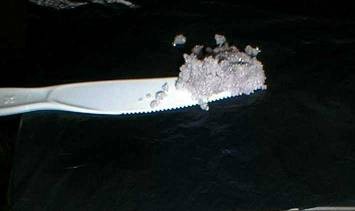
Plant experiments, and taste tests
The first batch I made was a small quantity to test the process. My guess is that I used approximately one-tenth of the dissolved gold/aqua regia solution, or maybe about 1/10 ounce of dissolved gold.
Once I had the output safely stored for future tests, I wondered about it's toxicity. I had some cleanup to do, and I hated to waste even the tiniest amount of m-state pot-rinsing, so I decided to try a plant experiment with the waste.
Aloe vera grows wild in this area. About two years before this experiment I had transplanted a small aloe plant to this worksite in case I needed it for an industrial burn or cut. Aloe juice is used as treatment for skin burns.. The plant did poorly for two years after transplantation. The spot I planted it was somewhat dry, and I had to throw water on it when I would visit to encourage it to grow. It did not substantially increase its size in two years.
Some companies are selling healing compounds extracted from aloe plants which are suspected of concentrating monatomics from the soil into their gelatinous leaves, so I thought that by dumping my monatomic-bearing pot rinsings on this plant I would test its toxic effect on the plant or see if it promoted growth. It did!
In a couple months, the aloe leaves swelled and greened up. The plant continued to grow from the crown. In about six months, the plant 'calved' and two more small plants sprang from the side base of the mother plant. A year later the mother plant grew a flower stalk and bloomed! This is rare in this region, and I had not added any water to the plant as I did in the past. The aloe was surviving and thriving on its own in this difficult environment. This is one of the things that encouraged me taste a tiny sample of the monatomic gold.
That was four or five years ago. This year the plant(s) continue to grow and thrive with no additional monatomics or water other than intermittent rains. It grew another flower stalk this year, which divided into three flower heads! This is dramatic growth and life-force! I am sure that this plant is full of healing monatomics now, should I ever need it.
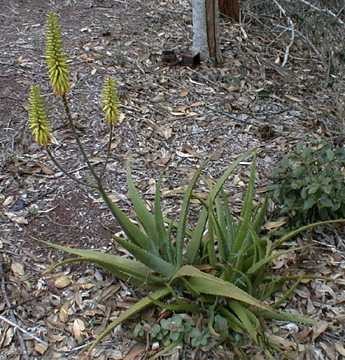
Here is an image of this healthy little plant
First taste tests
I observed the aloe for several months to be sure it would not die. I also left a solution of the precipitate out in an open glass tumbler for several days. Suddenly there was mold on the surface of the water, with streamer roots to the bottom of the tall glass tumbler! This stuff clearly feeds and supports life! So I decided to taste it.
I took the smallest little crystal I could break off from the mass... maybe half of a rice grain in size, and put it under my tongue. At first it has a brief 'ionic bite' (Probably the effect of the hydrogen atom?) and then I noticed a salty flavor... sodium chloride traces were still there, but not very strong. The crystal dissolves immediately to a gelatinous mass that keeps on dissolving into liquid. It is slippery and spreads fast throughout the liquid in the mouth. I could feel it penetrate the soft tissues under my tongue and around the gums. The effect was refreshing, as if these tissues were being oxygenated with a blast of fresh air.
I felt it penetrate under my tongue, and I sat quietly, observing myself, almost meditative in mood, not knowing what might come next. The effect was quite subtle. I got somewhat more meditative, but I found that when I focused my attention things became sharply lucid. I was prepared for something dramatic, but it never came at first taste. It just seemed to sharpen my awareness, wherever I directed it to.
By this time I was working on the boilings of my second pot. Now I am working with half of the remaining aqua regia solution, or roughly one-half ounce of gold in solution. I waited a week or two after my first ingestion, but did not suffer any ill effects. It seems to wear off in a day. Then I cautiously increased the dose in small amounts. I had three or four tastes now, and found that increasing the portion size made me very aware, and nervous, as if I had too much strong coffee. The only difference seemed that the m-state precipitate did not raise my heart rate like the coffee does. I would go out for a brisk walk to deal with this 'consciousness rush' and just enjoy watching the world go by as I walked through it.
After producing my second pot of the stuff (from 1/2oz. of pure crude gold) and scraping the pot clean, I decided to rinse the pot with distilled water and drink the rest, figuring it to be a couple rice-grains worth of residue. That night I lay awake in bed, restless. Sleep was difficult. My backbone and spinal cord were itchy, and my adrenalin levels were rising in fear. What had I done to myself? Finally, I just stopped trying to control or suppress the feelings and relaxed and let it come on. I shuddered, and had what can only be described as a Kundalini experience that shot through my spine and exploded in my head... and beyond. Meditators have tried to attain this experience for years. I was never that devoted, but I had read of the experience.
I am still curious about the timing of the Kundalini. It came on all by itself in the middle of the night, approximately six hours after ingesting the m-state pot rinsings. I did no meditating. I wonder if the timing of the onset had some external, or cosmic cause. It was close to midnight. After the shudder, I lay stunned, amazed, for a moment. When I realized I was alive and seemingly undamaged, I asked myself 'what was that?' Descriptions of the Kundalini came to me immediately, and I deduced that is what it was. With this realization I chuckled, relaxed, and had a wonderfully restful sleep for the rest of the night.
I have not repeated that experience, nor that heavy a dose. I 'nibble' at the stuff very intermittently. I still have most of that second batch of precipitate, and there is another 1/2 ounce of gold in solution for these past five years... awaiting the boils.
I'm consuming all the information on Barry Carter's site now, and I think I will put together a vortex trap and see what I can concentrate out of our volcanic-rock-filtered water in Honolulu. I'm studying alchemy also... but that is a long-term project.
Question - Would you care to relate how you feel after 5 years of consuming the m-gold?
I've been only a very intermittent consumer of the stuff after my kundalini experience. Clearly I have some more inner work to do to learn to handle the ormus better. I've recently been exposed to a Taoist Inner Alchemy technique of circulating chi, ching, and shen... the 'Three Gems', from an alchemist friend. I'm using this to clear my chakras and inner pathways.
I've also discovered from a chelation doctor in the past year that I carry a heavy toxic mercury load from my amalgam fillings. I'm working on getting that removed now, with mercury chelation to follow. My concern has been possible interactions with the ormus, so I have not consumed any lately. In comparative tests with other ormus workers/users, I seem to be very sensitive to it. I know of one fellow who consumed three times what it took to induce the kundalini in me, and he used that dose and some mental techniques to heal an arthritic knee from a 30-year old skiing injury.
Sometimes my body craves, or maybe the ormus 'calls'. I have found that larger doses of it tend to make me nervous, kind of like too much coffee, except that my heart rate does not increase like caffeine induces. I can only describe it as a 'consciousness rush'. One does not want to be around crowds or vexatious persons when one does this... it really jangles the nerves. Usually I will ingest just a grain or two for a gentle, meditative lift. It's nice to do in a quiet meditative setting. It helps the focus of the quiet mind.
I find that telepathic experiences and synchronistic experiences with other people I am in tune with will increase in frequency while on ormus. I've had a few others say 'I was just thinking about that...' when I communicate.
One really does become in tune with the universe, and the universal mind. Neil's ponderings of the 'divinity' aspect of the universe come to mind. I believe the Penrose-Hameroff theory of quantum consciousness based in the microtubules of our cells is the correct one.
http://www.consciousness.arizona.edu/hameroff/
Ingesting ormus increases the superconductive quantum activity in our microtubules, and opens the pathways to an infinity of universes, and answers.
Peace and
Aloha,
NaKaula
At the request of Aday, The author of this page gave more notes and requested that they be added to this page. I personally concure with everything written below.
CW
Aday's Request; I'd like to have the real white powder gold to speed things along. Only a few methods seem to hold promise right now #1)the Hudson patent, with Hanks notes. I wish Hank would publish all the meditations and 'non-scientific' things he did while preparing it.Ask, and ye shall receive!
On the one hand, it was nothing really special or specific.
On the other hand, how do I describe a lifetime of spiritual 'awareness' that led me up to that point? I am no Guru. I learned Transcendental Meditation back in the '70s, and learned it is a quiet, fourth state of consciousness. I sit quietly and listen to the source of my being. It opens the doors to awareness when later one is in the waking state. And I listen to my inner voices and inspirations. More than anything, I consider myself a student of consciousness, and my own consciousness is the laboratory.
I read the patent many times.... visualized it, contemplated it, reviewed it in my mind many, many times until I felt I really understood what was going on there. The last 'mystical' text I read was some channeled information of Hathor, the Egyptian Goddess of Fertility. The book was by Virginia Essene (now THAT's a pen-name if ever there was one!). Hudson later commented on this text when he heard of it, as it references the transition group ormes, and specifically states that among these, 'the finest is gold'. This was around 1995 as I recall, and Hudson wondered if this 'channeled' information had appeared before, or simultaneously, with his information hitting the 'net, or if the author referenced it after reading of Hudson's work. Regardless, I took it as an inspirational directive to go ahead and try this thing.
I struggled with my motives as to WHY I wanted to do this. Was I looking for long life? Was I being selfish in my wanting to do this? Was I spiritually prepared enough to do this? I prayed for guidance and selfless strength. I reasoned that I could always make the decision later to ingest the stuff, or not, if I was successful in producing it.
In doing the work, I had invested a fair amount of money in the gold, the acids, the glassware. I was motivated with extreme care by not wanting to lose the gold by making a mistake. I took my time. Weeks of time, working on weekends and stopping down when things crystallized. Through the process I kept referring to the patent instructions, and observing the work, and praying I would get it right. Now after having done it, I believe that the principles of the Alchemical operator apply here. You really have to be in the right state of mind, and let the work talk back to you by careful observation. Talk to it, coax it, treat it with respect from the beginning. You are eliciting a thing with a life of it's own.
The trickiest part is the pH shift under constant stirring to drop the precipitate. Be slow and careful with much, much stirring in between adding drops of NaOH... especially near the end. The reaction is very elastic, not like a normal chemical pH titration that happens nearly instantly. Sometimes you think you have it correct, and you stir for an hour and recheck the pH to find it has moved. Don't let it go beyond the mark.. ever! There lies failure, and you are very close to the edge in this operation.
After my kundalini experience, I have backed way off on my usage of the stuff. I only use it intermittently, in tiny doses. I use it for a meditative lift. I prefer to remain well grounded in physical reality, as I still have some lessons to learn here yet, I believe. Those who feel they must immediately activate their light body with total ormus saturation are probably making a mistake, in my belief, because they have no way of knowing if they are prepared enough, and no way of knowing what is coming to them. Heavy doses are like being thrown into the furnace of consciousness. It's hot, and it will consume you. I really believe that smaller doses over time are a much better and safer way to go. And they are awesome in their own subtle ways.
I have not, and will not, sell this stuff. It is Hudson's patent, and I will make no monetary gains from this work. I have given small samples to a rare few that I felt could utilize it best, test it, etc. but that is all. If you are really inspired, you will make your own. I have given all the clues and advice I can.
Peace and Aloha,
Hank
Some photos of the Hudson process
by M
The g-orme Cl solution is forest green in HCl with NaCl.
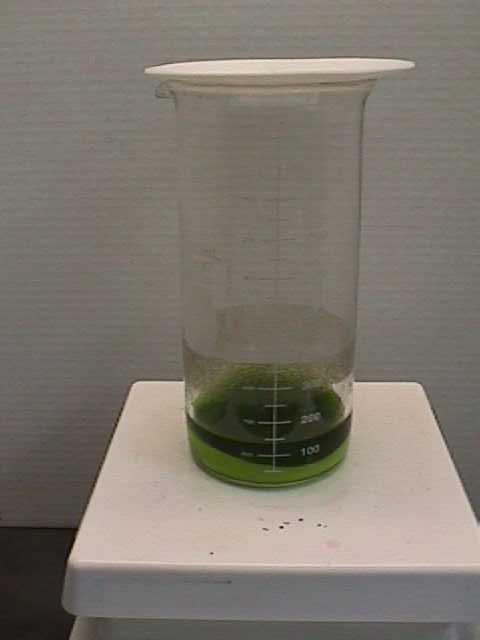
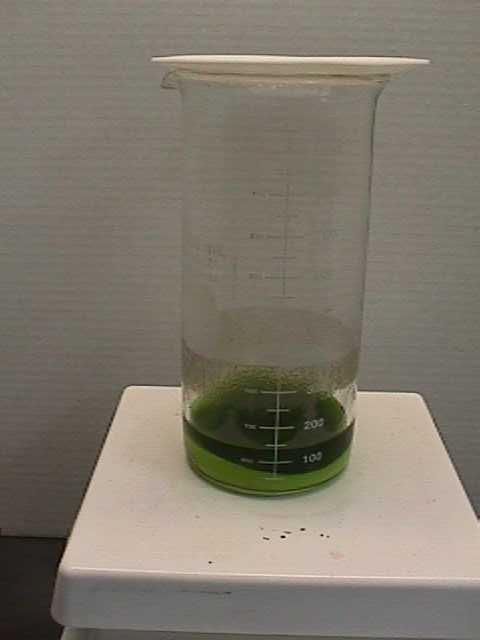
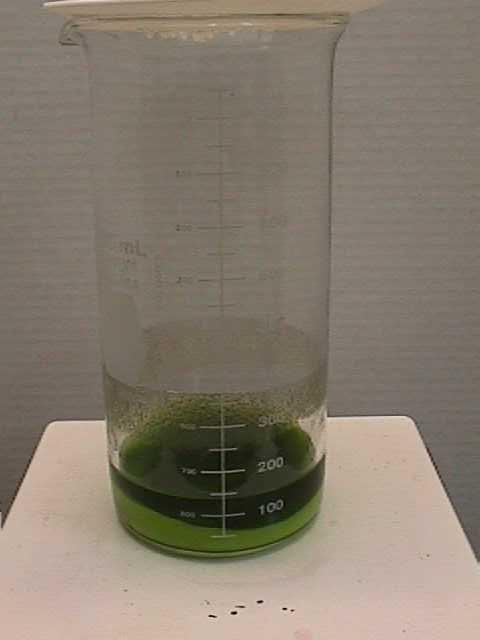
The HAu is a gray powder.
Hudson's annotated process
By Ron Talmage
I have
placed notes within the
I have
deleted some steps that are in the notes and also some of those that
are bypassed
due to changing procedure. The patent method was
intentionally made in such a manner, that it did work, but was pitted
with
problems / pitfalls & unnecessary steps that led to more problems /
pitfalls.
Preparation
of G-ORME
G-ORME was
prepared from metallic gold as follows:
(1) 50 mg
gold (99.99% pure) were dispersed in 200 ml aqua regia to provide
clusters of
gold atoms.
I am
currently making a batch whereby I started with (stiff mix aqua
regia)1000 ml
of 70% Nitric Acid and 2000 ml of 37.5% Hydrochloric. I also have
provided cooling to the flask to prevent temps above 70 F during the
dissolving
process of 33 grams of gold. (You may want to note that I am working
with large
flasks 4000 & 6000 ml, and thick walled vacuum flasks.)
I also
have started a drip of a stiff NaOH solution with 280 ml total to be
added
before first boil down.
Boil
downs should be as gentle as possible, I.E. vapor coming off of top of
liquid,
tiny or no bubbles.
Next
perform boil down to the point where salts are formed, but not all the
way dry.
(David Hudson verified that his definitions of boil was gentler than
most
peoples and his definition of just dry still contained moisture. This
has been
verified as being correct path from other's)
Then add
more aqua regia solution, and repeat with adding NaOH . The repeated
dissolving
in Aqua Regia and the Addition of NaOH in solution has the effect of
breaking
down the gold clusters faster and preventing their recombining. [Use
care to
vent the fumes somewhere else from the start.] Minimizing the gold
metal fall
back from the start with the addition of Na is an improvement.
Here is a
improvement in evidence ( I believe). When I dissolved the Au in the
Aqua
Regia, it was a very dark cherry red (darker as more gold was
dissolved) to
start with instead of clear like usual, this indicates to me that the
particle
size is smaller. I do not have a Merk Index on hand, but do understand
that the
color changes with particle size and the other elements present.
Then
after you have finished your third Aqua Regia boil down proceed to step
2.
[Small
amounts of HAu'X'H2O will be formed with each boil down, making the
boil downs
as gentile as possible will help to keep them in the flask,
recondencing the
off gases in a separate flask and lowering there pH to 7 will provide
small
amounts of HAu'X'H2O to be added to the solution during step 9.]
[Gold
metal that has been dissolved with aqua regia, and subsequently
converted to
gold chloride by repeated evaporation with HCl to remove nitrates, is
commonly
referred to as the acid chloride solution of AuCl3 or HAuCl4. It has
been
recognized that the recovery of gold metal from a solution formed from
aqua
regia is made more difficult in proportion to the amount of HNO3 used
in the
initial dissolution procedures. It is not commonly understood, however,
why the
gold that is dissolved with less HNO3 is easier to reduce to the metal
from a
chloride solution than gold that is dissolved using a greater amount of
HNO3.
Gold in both solutions is generally regarded as being present in the
form of a
free gold cation.
From the
study of the behavior of gold and other transition metals in solution,
it is
now believed that all such metals have atomic aggregations and occur as
at
least diatoms under normal conditions of dissolution . Under either
acid or
strong base dissolution, the transition metal will not normally
dissolve beyond
the diatom due to the extremely strong interatomic d and s orbital
bonding. A
gold atom, for example, has a single atom electron orbital
configuration of
d10s1. When the gold salts originate from a metal having gold-gold
bonding, the
salts contain very tightly bound diatoms or larger clusters of gold.
Under the
normal aqueous acid chemistry used for transition metals, solutions of
the
metals will always contain two or tore atoms in the cluster form.
It is
now recognized by most chemists who regularly handle chlorides of gold
that
gold metal ceases to disaggregate when the HNO3 is removed and in fact
can
reaggregate under certain conditions and precipitate out of HCl
solutions as
metal. This recognition has led to the discovery that gold metal salts
will
exist in HCl solutions originating from metals as clusters of Au2Cl6,
Au3Cl9,]
(2) 60 ml
concentrated hydrochloric acid were added to the dispersion and the
mixture was
brought to boil, and continued boiling until the volume was reduced to
approximately 10-15 ml. 60 ml concentrated HCl were added, and the
sample
brought to boil and checked for evolution of NOCl fumes. The process
was
repeated until no further fumes evolved, thus indicating that the
nitric acid
had been removed and the gold had been converted completely to the gold
chloride.
[Adding
2000 ml of NaOH solution prior to adding HCI (sufficiently to lower pH
to 2 or
less) is the next key to a faster break down. Swings in pH have been
found to
break apart the gold clusters faster than boil downs alone.]
August did
boil downs to about 40 days to get the green chloride solution.
If we can
make a color change with each pH swing and boil down, then it will be a
lot
faster.
[An aqua
regia solution of metallic gold is prepared. This solution contains
clusters of
gold chlorides of random size and degrees of aggregation. HCl is added
to the
solution and it is repeatedly evaporated with a large excess of NaCl
(20:1
moles Na to moles Au) to moist salts. The addition of NaCl allows the
eventual
formation of NaAuCl4/, after all HNO3 is removed from the solution. The
sodium,
like gold, has only one unpaired S electron and, accordingly, tends to
form
clusters of at least two atoms. The sodium, however, does not d
orbitally
overlap the gold atom as it has no d electrons, resulting in a surface
reaction
between the sodium atoms and the gold atoms. This results in a
weakening of the
gold-gold cluster stability and causes the eventual formation of a
sodium-gold
linear bond with a weakened d orbital activity in the individual gold
atoms.
The sodium-gold compound, formed by repeated evaporation to salts, will
provide
a chloride of sodium-gold. In these salts the sodium and gold are
believed to
be charged positive, i.e., have lost electrons: and the chlorine is
negative,
i.e., has gained electrons. When the salts are dissolved in water and
the pH
slowly adjusted to neutral, full aquation of the sodium-gold diatom
will slowly
occur and chloride is removed from the complex. Chemical reduction of
the
sodium-gold solution results in the formation of a sodium auride.
Continued
aquation results in disassociation of the gold atom from the sodium and
the
eventual formation of a protonated auride of gold as a grey
precipitate.
Subsequent annealing produces the G-ORME. The G-ORME has an electron
rearrangement whereby it acquires a d orbital hole or holes which share
energy
with an electron or electrons. This pairing occurs under the influence
of a
magnetic field external to the field of the electrons.]
(6) Sodium
chloride is added in an amount whereby the sodium is present at a ratio
20
moles sodium per mole of gold. The solution is then diluted with
deionized
water to a volume of 400 ml. The presence of the aqueous sodium
chloride
provides the salt Na2Au2Cl8. The presence of water is essential to
break apart
the diatoms of gold.
I do not
believe that the NaCl concentration is a major factor, it does need to
be high,
but I believe that it can be significantly lower than Patent states.
The
addition of NaCl appears to be a way of adding Na while preserving the
Cl in
the solution which is lost with each boil off. Having a lot of salt
in the mix
is key to reducing the particle size of the Au. After all we are trying
to
achieve NaAu which will transition to HAu'X'H2O when the pH is brought
below 12
to neutral.
(7) The
aqueous sodium chloride solution is very gently boiled to a just dry
salt, and
thereafter the salts were taken up alternatively in 200 ml deionized
water and
300 ml 6M hydrochloric acid until no further change in color is
evidenced. The
6M hydrochloric acid is used in the last treatment.
Obtain
forest green colored solution by combination of pH swings and boil
downs before
proceeding. A forest green color may be obtained before steps 6 & 7
which
allows them to be eliminated
(8) After
the last treatment with 6M hydrochloric acid, and subsequent boil down,
the
just dry salt is diluted with 400 ml deionized water to provide a
monoatomic
gold salt solution of NaAuCl2'XH2O. The pH is approximately 1.0.
This is
forest green solution.
Here are
brief descriptions of the Pic's.
GreenFlask4000.JPG
I have a
funny observation and question. In the boil down process, it seems that
the
color gets lighter when the liquid approaches 1400 ml from the approx
3300 that
I start the boiling down at. It seemed very dark around 2000 ml this
time
around. The Flask as you see it contains close to one oz of Au and has
been
brought up and down several times in pH with NaOH solution and Aqua
Regia
(strong mix 50/50), and boiled down a couple of times. There is a nice
light
brown gas inside the flask at present, I have the bottom of the rubber
stopper
covered with PTFE to protect the rubber. The hose's are PP plastic I
believe
and seem to hold up fairly well to the kings water. You asked for a
white
background and it is bright white 24lb paper under and around the
Flask. It's a
4000 ml flask from corning. With the initial gold dissolving into a
cherry red
liquid. I scorched the salts once and dissolved them all over again,
and
decided to discount the prior boil downs because of the scorch. The
flask is
slightly tilted towards the front in the pic. Any Idea why it gets
lighter when
the fluid level gets close to 1400 ml? Sorry the pic is not better, it
is a
cheap camera, and the lighting was not real good in that part of the
lab.
JustDrySaltLightened
is lightened due to the sun setting and there being low light.
JustDrySaltUnaltered
is the same pic without the color lightened.
NoScorchBottom
shows the bottom of the flask with no scorching of salt, the secret of
doing
this is even heat, this is derived by using a sand box that the flask
sits in
while being heated. It's an old trick
EvenHeat.jpg shows an example of the portable Wizards Sand
Box prior to putting it on the stove. Also to
prevent ormus loss, I use a gas stove top much like August did.
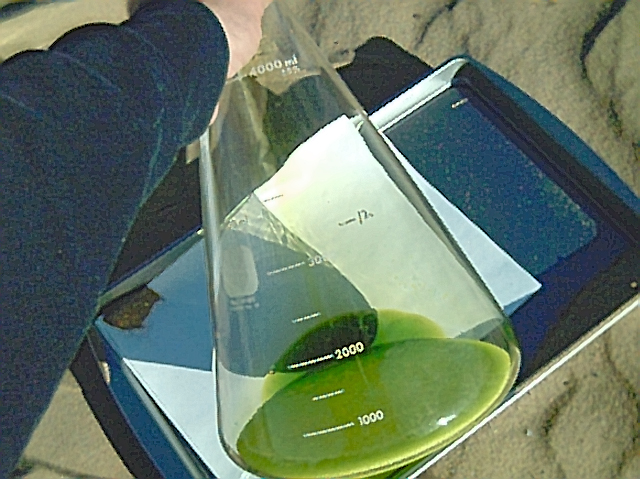
JustDrySomeLiquidLeft
shows that if you put it on it's side for long enough some liquid will
come out
and how much.
Titrated-NaOH
is after the boil down, 500ml of distilled water is added and then
titrated
with NaOH solution. It gets real dark. And you can not see through it.
TitratedAquaRegia
is after the NaOH and as you can see, the solution gets lighter and is
transparent.
by August
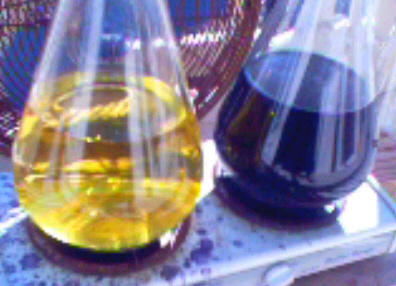
My gold is still boiling yellow, heres a pic, its been going for a couple of
weeks or more.....how crappin long does this take?
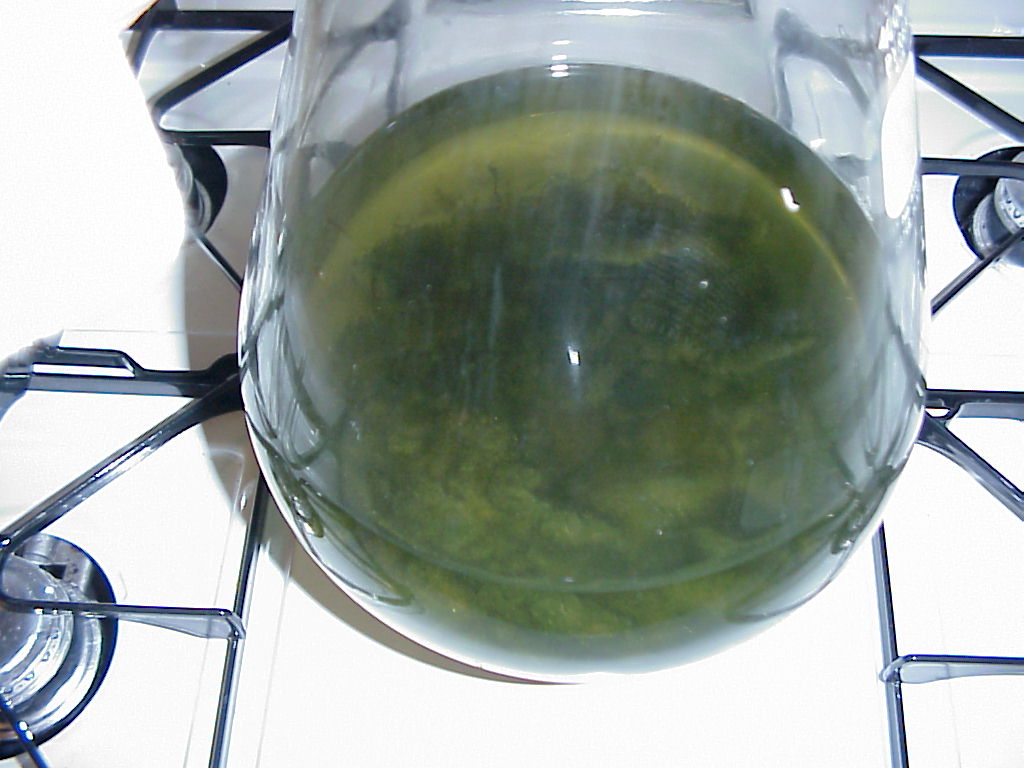
While bringing the gold to the green stage, a second 4000 ml flask was
processing iridium. the gold started its green color on 2/11 and the next
day the iridium went green. It was deep red chloride for a month.
The gold should turn just as dark green. Perhaps tonight when I salt it out.
Fresh gold chloride monatomic.
If it never gets to green it never gets to monatoms
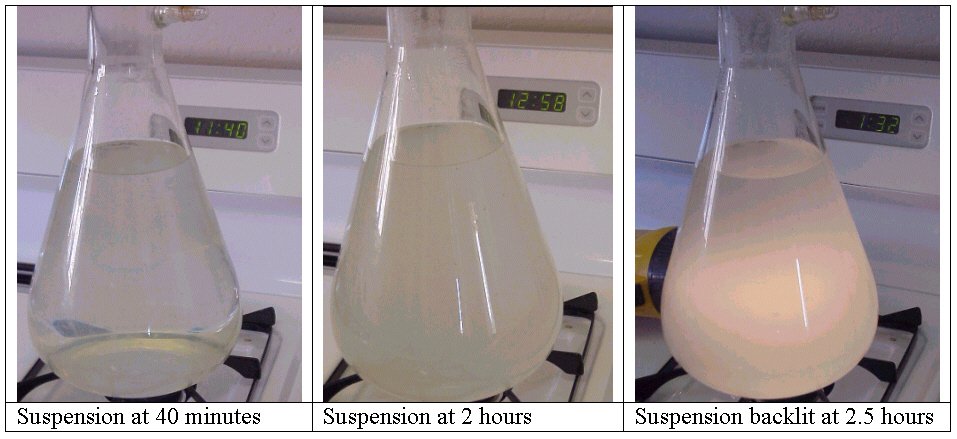
Occlusion Sequence
The stuff was almost clear to start.
I wrote you all about this a week or so ago when I also followed up with an early evaluation stating that there appeared to be no ppt in the titrated 6M HCl collected as vapor and condensed into liquid.
But I was curious. I thought maybe it was too fine to see and let the jar sit for a week. I fine off white flocculant fell to the bottom of the jar. It can only be monatomic gold
Well, I think the following method is an excellent side extraction going on during salt reductions of disolved transition metals.
1 do a fusion on gold using sodium peroxide and sodium hydroxide
2 melt the cake into 6M HCl and add more HCl and HClO4 and boil 6hrs
3 at the end of 6 hrs adjust pH to pH12 and boil 6 hrs
4 cool, filter, adjust filtrate to pH3
5 reduce filtrate to half the starting volume
6 on a spin table mix in 6M HCl (salting occurs immediately)
7 reduce to salt repeatedly in a 4L flask with a side nipple. Put a stopper in the top, attached a automotive high temperature neoprene gasoline hose to
the flask neck side nipple and connect the other end to a condenser tube to cool the evaporating HCl vapor.
8 collect the vapor and adjust pH to pH7
9 Let sit until the PPT falls to the bottom of the settling vessel
you won't get much each gallon, maybe 10 or 20 ml, but it is monatomic hydroxide.
wash it like regular precip

Yes, you can convert Gold to a white elemental non reactive powder
If patience is a virtue, I must be loaded with virtue
And, I suppose I became an alchemist on 5-29-2002
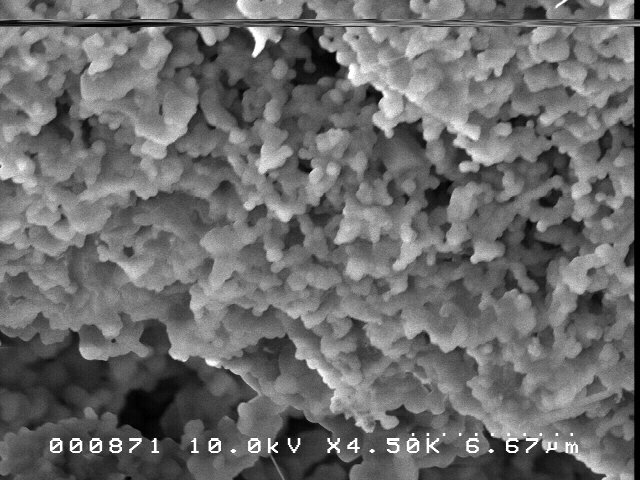
Heres a picture of pure monatomic gold (Au+3) from a session on the scanning electron microscope at Caltech. What you are seeing are bound state spheres of monatomic gold reagions electrostatically bound into the beautiful material that it is.....
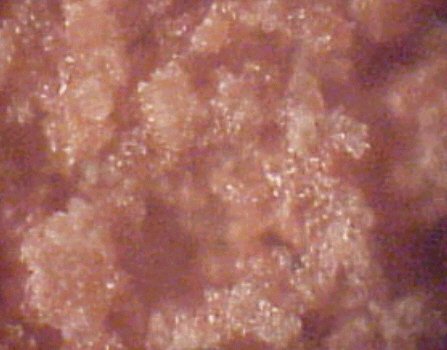
I have made a small amount of transparent gold, problem is, it's rather porous. It was made in a helium atmosphere here on earth. I'm trying to work some of my old NASA contacts to see if I could get a ride up and have in fact arranged for a canadian sonic furnace that is space rated from my CSA contacts in Ottowa if I can get a spot. Know anyone with contacts in Russia and the 10M fee to ride to the station? Ha! yeah right.
I'm figuring that if I can try some various samples under other heavier enert gases like krypton or xenon it might be more ordered.
But, yeah, the idea I came up with back in 1998 worked and I'm in testing to determine its qualities. Damn but this stuff takes time with short development funds. The material is in testing to show if there is photon capacitance. The original patent design is for a material to capture quanta at the resonant frequency of the material. The material shields all frequencies but is transparent to the resonant frequency or those near it in a small window of frequencies into the quantum matrix. Then the idea is to extract the frequencies by tesla transmission.
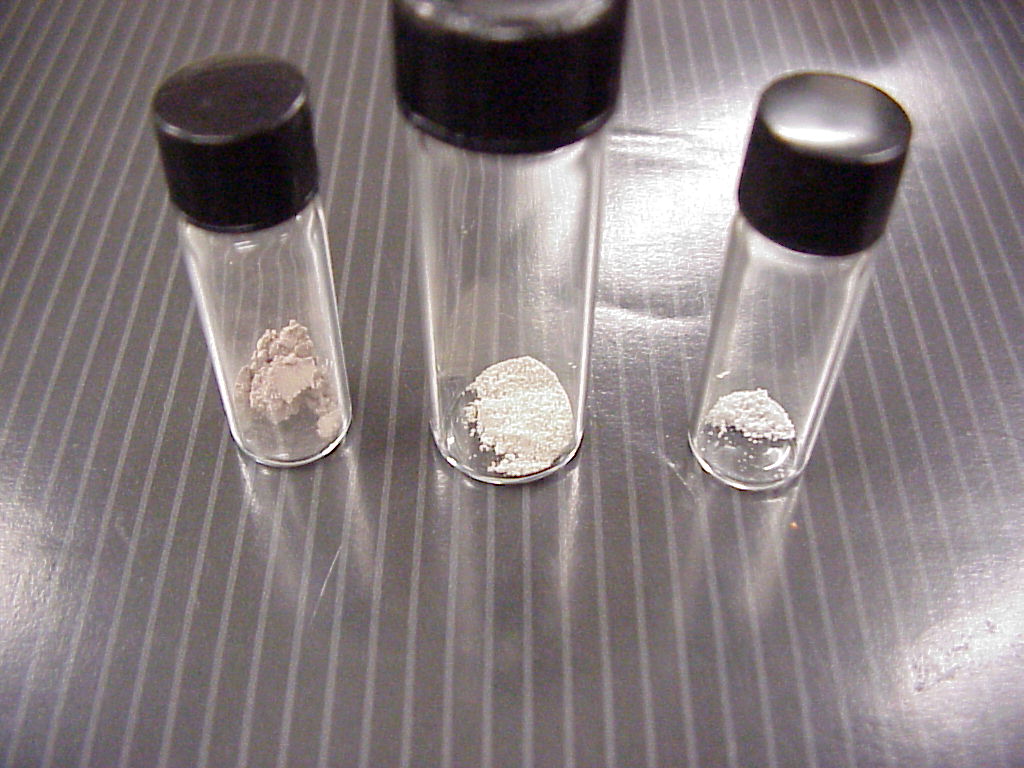
rhodium, iridium and gold refined powder
Date: Mon, 05 Aug 2002 00:44:41 -0400
I thought everyone might like to see monatomic rhodium, iridium and gold refined powder.
The powder is kept in an argon atmosphere in sealed bottles.
I seem to be rather happy, perhaps its the month we are in.
Ha
august
by Barry Carter
Summary
Making the purple/red precipitate- Place a quarter ounce of 99.99 (or better) pure gold (beads or smaller) in a laboratory grade glass container.
- Place your glass container in a larger plastic or glass catch basin to catch any overflow in case the peroxide causes too rapid bubbling and the acid overflows. It is easiest to see color in the liquid in the inner glass container if the catch basin is white. A liter size plastic tub works well.
- Add 50 milliliters of distilled water.
- Add 50 milliliters of 30-40% HCl. (Always add acid to water, never water to acid.)
- Add 3 milliliters of pure sodium chloride.
- Add 3 milliliters of 35% hydrogen peroxide. Weaker peroxide solutions can be used but you must use correspondingly more of them.
- Set an inverted plastic cup loosely over the neck of the inside glass container. This will direct any overflow downward if you accidentally get too much peroxide in the mix, it will also keep anything from falling into the neck of the inner bottle.
- Place this entire system in a large cardboard box and fold the lid closed. This will help keep the system warm and dark and will help prevent it from being disturbed.
- This process will produce chlorine gas which is very toxic. It should be performed in a warm, well ventilated area.
- Periodically check the mixture. There should be a continuous stream of bubbles rising from most of the gold beads. The glass container will become warm to the touch. After about an hour, the liquid in the glass container should have a distinctly yellow tint.
- When the bubbles significantly slow down, add a few more drops of peroxide. Don't add too much since it takes a few minutes for the bubbles to increase.
- Continue to check and add for four to eight hours.
- Leave the solution to work over night.
- The next day, examine the liquid in the inner glass container. It should be a yellow/green color.
- Pour this liquid into a Pyrex glass container suitable for boiling the liquid. This container should be capable of holding a liter of water. It is best if this container is clear. Keep the liquid from contact with any metal other than the gold.
- Heat the liquid, preferably over a gas flame.
- When the liquid is at about 70-80 degrees Celsius, you can start to add the liquid lye solution which is described in the ORMUS document.
- Slowly drip this lye solution into the acid solution while stirring it with a glass stirring rod. This process is quite boring and will take a couple of hours. If you drip too fast, you will get a different outcome.
- Periodically check the pH of the liquid by dripping some of it on pH paper on a white plate to the side of the liquid container. Do not use an electronic pH meter since they have metal electrodes which might introduce contaminants into the mix.
- When the pH of the liquid is nearly neutral, the yellow tint will be gone and the liquid will be clear.
- As the pH nears 8.5 the liquid will get a pink to purple tint. This color will deepen as you bring the pH over 8.5.
- It is quite common to add just a few drops of lye water and cause the pH to shoot up above 12. If this happens be ready to add a few drops of 15% HCl to bring it back down.
- When you get the purple/red color, you are done with your chemical changes.
- Pour the liquid into a tall, thin, clear glass container, like a graduated cylinder.
- Cover this container with an inverted plastic cup and place it in a magnetically shielded box to let the precipitate settle for a day or two.
- Suck the liquid from above the precipitate off with a syringe or siphon. Save this liquid and adjust its pH down to neutral. This liquid is mostly salt water but should contain significant m-state gold. If you have used pure chemicals in your process it will have no contaminants, it could be ingested in small amounts (5 ml or so) mixed into drinking water.
- Take the purple precipitate and wash it with distilled water as described in the ORMUS document. Save all of the wash water for ingestion.
- Do the first wash on the purple precipitate in the normal way.
- With the second wash , save the wash water for consumption.
- I have the precipitate in a tall thin vial (2 X 15 centimeters).
- There is about 2 millimeters of precipitate in the bottom of the vial.
- Fill the remainder of the vial with distilled water and shake it well.
- Let it settle for a day or two and take the clear liquid off the top, leaving the purple precipitate to energize the next batch.
- Put the liquid off the top into an eyedropper bottle.
- I use two eyedropper squirts in the morning and evening.
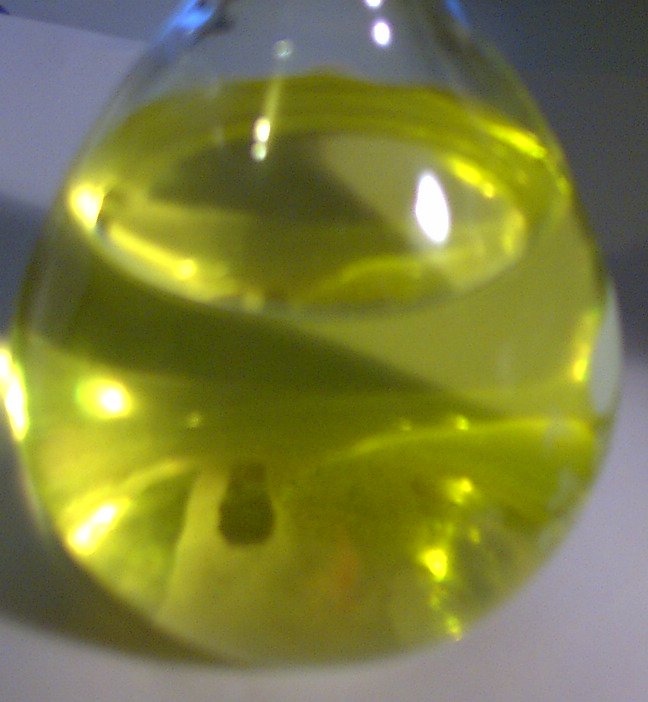
Jim and I first "discovered" this
method in Portland, Oregon on May 7, 1997. I videotaped our discovery
of this method. Below are a couple of images from this videotape.
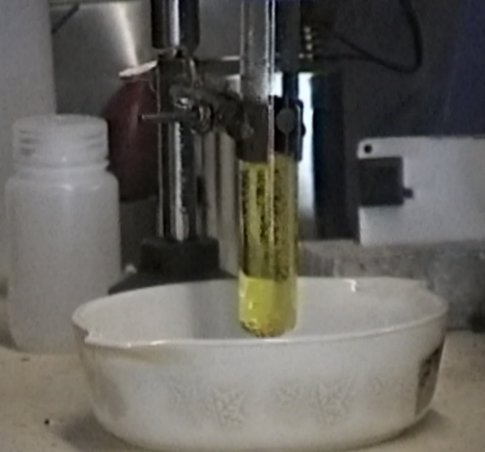
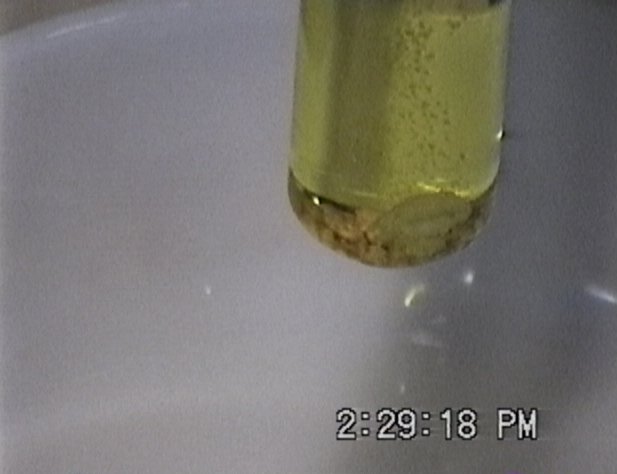
Closeup of peroxide bubbles off of gold beads and salt crystal
Here are my original notes from the first couple of times that I tried this process alone. Note that the procedure has changed significantly from what is described in these early notes.
Place a quarter ounce of gold (beads or smaller) in a test tube. Cover the beads with about ten milliliters of 31% HCl. Add a few drops of 35% hydrogen peroxide. (Be careful to have a catch container under the test tube in case the mixture bubbles over. Also be careful not to breathe the fumes produced by this process. Work outside or under a fume hood.) Soon after the peroxide is added, you will notice bubbles rising, mostly from the gold beads. Leave this process to "cook" for an hour or two. If you notice that the bubbles have stopped, add a few more drops of peroxide. Be careful not to add too much as this will cause the mixture to bubble over. Allow this process to continue for at least eight hours. M-state materials seem to need time to "settle in" to their new role.
While you are "cooking" the gold, mix some tri-sodium phosphate with water. Put enough TSP into about 100 ml of distilled water that some will not go into solution. When as much TSP as possible is dissolved in the water, heat the TSP solution in a boiling water bath. This dissociates the tri-sodium portion from the rest of the molecule. Set this solution aside for several hours and let it "get comfortable".
You can do both of these processes before going to bed and let them "steep" over night. When you are ready to mix the two solutions, pour the contents of the gold test tube into a glass container. Heat it to almost boiling point, either directly or in a water bath. Slowly drip the TSP solution into the gold chloride solution. As you approach pH 7 you can change to lye water. Bring the solution slowly up to pH 8.5. After this point you should notice a small amount of white or off white precipitate forming in your solution. Settle or filter this material out and wash it. It can be quite slow to settle and you may need to let it settle for several hours or over night.
The washed white precipitate will dissolve in HCl resulting in a green solution. The first time I brought this low pH solution back up to above 8.5 with lye it resulted in some purple-red precipitation on the top.
If you use the powdered TSP instead of a liquid solution you may notice that a small red-brown cloud will form around each particle of the TSP and quickly dissipate. As the pH approaches neutral, you will notice that the red-brown cloud persists for a longer and longer period of time. Above pH neutral you will notice that the cloud formed by each drop of TSP solution is almost black for a moment before turning red-brown and precipitating.
As the pH gets above 8.5 you will notice that the drops of TSP no longer have the dark color at first. If you exceed pH 10.8 you will notice that the solution will start to bubble rapidly. If this happens be prepared with some HCl to take the solution back down to a safer range.
The red-brown cloud forms into a brick red precipitate. If the TSP is added too quickly, you may get a black precipitate. Some of both of these precipitates will remain partially suspended in the liquid for several days. A centrifuge will help in concentrating and washing the red precipitate but it is not necessary.
The washed red precipitate turns brown in HCl but does not dissolve.
It is possible to make the white precipitate and then take the remaining liquid and get the red precipitate. To do this take the liquid which was separated from the white precipitate and take it back down to pH 4 or 5. Add powdered TSP and you should get the red precipitate. I have also gotten the red precipitate and a brick red sponge like material when quickly adding a squirt of 35% hydrogen peroxide. The red spongy material contained metallic gold flakes when I dried it and broke it open.
This process uses tri-sodium phosphate. Phosphorus and some phosphorus compounds are quite poisonous. I do not know whether the various precipitates contain phosphorus or phosphorus compounds. One time I tasted some of the red precipitate after only one washing and it tasted awful and I felt like I had been poisoned (or perhaps as if I had a kundalini experience, it's hard to tell the difference sometimes).
I also put a teaspoon of TSP in half a cup of water with some gold beads in a 125 ml Nalgene container. I put the lid on tightly and floated this container in a crock pot for about 18 hours at a temperature of approximately 75 degrees Celsius. Jim said that he got a white precipitate from this process. I did not notice a white precipitate except in the water in the crock pot which I assume was the result of the liquid from the Nalgene container leaking out under pressure. I am not sure whether or not I injected some hydrogen peroxide into the mixture.
I forgot about this mixture for a couple of days. When I opened it up again, I noticed some foam floating on the top. Then I noticed that the foam was solid. I also noticed that there seemed to be a clear rigid layer of something around these floaters.
I poured the contents of the Nalgene container (except for the gold) into a small glass beaker so that I could get a better look at the floating stuff. I took a small plastic measuring spoon and dipped as much of the floating stuff as I could into a small test tube. I then took a metal tipped syringe and sucked the remaining liquid out of the test tube and injected some distilled water into the test tube.
The material did not significantly dissolve in the distilled water. I repeated this process three times to "wash" the floating precipitate. When this was done I took the metal tipped syringe and snagged one of the floating bits. I tasted this material and it had a very pleasant sweet taste. It seemed to make me feel slightly good all over but without any drug distortion. When I first started handling this stuff, my lips started to feel slippery. When I tasted it they got very slippery.
I just tasted it again. God that stuff tastes good.
Today I spoke with a person who is quite experienced in working with m-state materials. This person told me that it is unlikely that I am producing a poison and suggested that I try converting lead to gold using the red material that I have produced. This person said that this is the guaranteed proof that the red material is the right stuff. I have not done this test yet. I am not sure when I will get around to it.
Last night (7/20/97) I finally got around to cooking up some green gold chloride that I made using a variant of the method described above. Everything is the same except that I started with a dilute HCl solution. Basically I mixed 100 ml HCl and 100 ml water in the flask with the gold beads. I added several drops of hydrogen peroxide and let this mixture sit for about 24 hours. At the end of that time the solution had a light green tint. No hint of yellow.
I took this solution and added about two teaspoons of sodium phosphate tribasic (Na3PO4 12H2O) dissolved in a cup of distilled water. (Be clear that the sodium phosphate was dissolved in water before it was added to the gold chloride solution.) I basically poured the STP solution into the gold chloride solution since the gold chloride was so acidic that I was nowhere near bringing it up to neutral with the amount of TSP that I was adding.
I continued adding TSP and started adding lye water (one half tablespoon of lye in a cup of water). I was adding these with an eye dropper about a dropper full at a time. As the solution got closer to pH 7 it started to loose the green color.
While I was stirring in the TSP and lye solutions I noticed that I was feeling quite high. It was a bit like a pot high, but without the distortion and memory loss that pot gives. I also noticed my lips were getting quite sweet and slippery. I asked the experienced person about this. The reply was that this is quite common when working with these materials. To avoid it you should put some pure, lab grade, sodium chloride in with your working solution. Without the salt, the m-state material will evaporate with the water and much of it will be lost.
When I reached pH 7 I slowed down to a drop by drop addition with the eyedropper. Despite my precautions, I overshot and took the solution up to pH 12 or higher. (Since there is not likely to be anything precipitating out of this solution but gold, I did not worry about producing a Gilcrest precipitate.) When the pH went up to 12 the solution quickly turned from a colorless transparent liquid to a candy apple red color which soon showed some red precipitate. I added some HCl to bring the pH back down to neutral but the color stayed. I gradually added lye water to bring the pH up to about 10 and then took the solution off the burner to cool.
During this process I was noticing that the "high" feeling was becoming more and more pronounced. It never caused any dysfunction but I decided that I should be very meticulous and careful to avoid doing anything clumsy.
As the solution cooled, the precipitate darkened to a rich purple red color. The precipitate that collected at the bottom was a dark purple, about the color of grape juice. I left this stuff to settle out over night and this morning I centrifuged out most of the precipitate that had collected on the bottom of the graduated cylinder. There was about 3 ml of the wet precipitate. I centrifuged and washed the precipitate three times and tasted a very small amount of the material. It had the same neutral taste that I expect from this stuff. It also gave me a buzz like breathing it had last night.
I dried the cleaned precipitate on a Corelle plate on my kitchen range. It dried to a purple-black material. There was no noticeable magnetic response.
This precipitate feels like the best m-state stuff that I have made yet. Previously I have wondered if I was really feeling anything with any of the other stuff I made. The feeling was subtle, so to speak. There was nothing subtle about this material. It made me feel fine and there was none of the electric jangle that I felt when I first tasted some poorly washed brick red precipitate from an earlier experiment. This material did not feel like it could be poison like the earlier material did.
I am going to start another batch of gold chloride tomorrow to see if I can duplicate this stuff. Soon I hope to try the applying some of this material in bees wax to some molten lead. The person I spoke to about this has done this and gotten the lead to turn to gold. They also know of others who have partially changed silver coins that they use to demonstrate that they have done this process. This person knows several others that have made the material which changes lead or silver to gold.
On 7/24/97 I duplicated the process above. I soaked about an eighth ounce of gold beads in 100 ml of 31% muriatic acid (HCl) diluted by 100 ml of distilled water. To this I added several drops of hydrogen peroxide over a period of a day and a half. On the second day I dissolved half a tablespoon of TSP in 125 ml of distilled water and put this in a sealed Nalgene container in boiling water for about 20 minutes. I then slowly poured this TSP solution into the green gold chloride solution, which was heated to near boiling. Then I slowly poured half a cup of lye solution (made by adding 2 teaspoons of lye to half a cup of water), while stirring, into the mix. I then slowly stirred another half tablespoon of TSP dissolved in 125 ml of distilled water into the mix.
At this point the solution was considerable lighter but this might just be due to dilution. From this point I added lye water (of the same concentration mentioned above) on an eyedropper by eyedropper basis until the liquid got up to pH neutral. Throughout the entire process I added a total of 3 teaspoons of TSP dissolved in 250 ml of distilled water and almost 6 teaspoons of lye dissolved in 1.5 cups (350 ml) of water.
As I brought the pH above 8.5 the solution started turning purple till it was quite purple around pH 10.5. I again overshot the pH and went up to around 12. I was using pH paper and not a meter since the meter does not work reliably in the strong acid. I brought the pH back down to around 8.5 with a few drops of a 15% dilution of muriatic acid and waited for the precipitate to drop.
Since there was a certain amount of variation in my procedure between each experiment, I am fairly confident that this is a robust process and does not depend on subtle variables like the phases of the moon or the shape of the container.
This process yielded approximately 3 ml of precipitate. This purple precipitate is fairly slow to drop. Some of it will stay suspended for days. It seems that the larger particles drop more quickly. There was one flake of metallic gold floating on the top of the solution today. I am not sure what this means.
I concentrated the precipitate which dropped the quickest and put the remainder in a quart glass canister with a plastic sealing lid. I then set this canister on a magnetic stirrer which has a u shaped magnetic element. When I turned it on I noticed that there were two or three particles which seemed to move in response to the magnet. These particles, or aggregations of particles, were somewhat elongated and had two motions. They would spin around their internal axis at approximately the same speed as the magnetic stirrer. They would also orbit around the center of the container in an orbit which did not exceed an inch in diameter. This motion was much slower, probably since the viscosity of the water prevented faster movement. I could get these little structures to spin on their own axis quite rapidly simply by increasing the speed of the stirrer. They seemed to maintain a distance of about a quarter inch above the bottom of the glass canister.
I also looked for any similar response in the containers with the concentrated precipitate but saw no movement in them. The two or three particles could be an anomaly caused by some iron or other contaminant though I have been quite careful to use only clean glassware and materials.
I washed the purple precipitate and saved the first wash in the glass canister. I consumed the material after the second wash.
I noticed some slight spaceyness last night but not to the extent that it happened the first time. This morning I noticed somewhat more spaceyness while I was working with the samples. This effect became quite profound while I was working with the magnetic stirrer. If anything it is more intense than it was the last time. Even working with a sealed container, I still noticed a significant effect from something. I am not sure whether it was an effect of the spinning magnetic fields of the motor and the magnet on me directly or if it was a resonance effect between me and the liquid in the canister or if it was simply a result of me breathing m-state gold gas (or some other gas, for that matter).
It is difficult to characterize this feeling. I will try to surround it so you might have an opportunity to pounce on it. It is a bit like a low blood sugar feeling. It is difficult to focus on one thing yet when I do get focused I can stay focused without getting diverted. While I have this feeling I feel inclined to be slow and deliberate. This may be intellect directing me to mitigate for clumsiness. There is very much of an in-the-moment feel to this.
Sometimes I notice a slight stomach ache when I am working with these materials. Perhaps I even get a touch of diarrhea. I sometimes get a slightly acid stomach when I eat these things or when I am around them. Eating something else seems to somewhat moderate the feelings related to this stuff. My snot is slipperier and my lips get slicker and sweeter. Orgasms last longer and are more intense.
I am storing these samples in metal canisters since Jim says that this helps to stabilize them.
Here is another variation on the red precipitate process worked out by someone else:
I begin with 50 mls of distilled water in a 250 ml beaker. I pour in 50 ml's of 36.5% HCl. I drop two 1/16th ounce pieces of gold into the bottom. I then add 70 mls of 6% H2O2. (Or until i see bubbles start to really come off. I qualify this by an even stream of bubbles coming off the gold. Not a few bubbles here and there, a nice even stream.) I then add 50 drops of concentrated KNO3. I add 30 drops of NaCl.
I let this "cook" overnight. It goes for around 36 hours before the bubbles stop. I let it go until there are no more bubbles. The solution has a greenish-yellowish tint to it. The solution need not be covered but i put something over it to avoid getting dust in it.
I heat the solution (when there are no more bubbles of course) until 75º C and then I begin to add dropwise 50% NaOH. This is an exothermic reaction and can cause the solution to get to near boiling very quickly. I like to keep it below 80oC. I feel most comfortable at this temperature. Any hotter and the solution is going to start spattering nasty acid at you.
The pH will remain between 1 and 2 for a long time. But continue to drop slowly. The solution will get darker yellow as you proceed. At some point (around 30 mls of 50% NaOH) the pH will start to shift and the solution will turn a faint pink-purple colour. This is the sign that you are close to getting the huge pH shift and your ppt. The colour will return to yellow. Then after a few more drops, you will be able to witness the pH rise quickly to around 12. (With a pH meter. This is not essential) At this point the whole solution will be purple or red colour
and you will see a ppt. begin to settle.
I have seen purple and cherry red ppts. at this point.
I ran your process using silver. As i brought the pH up, i began to get a ppt.
The colour of the ppt. is a beautiful CITRINE!!!! The exact colour that i believe J was trying to explain is essential for the silver process.
I have running gold and silver at the same time and then bringing up the pH. I have yielded a very nice ppt. but haven't eaten any yet. What i have eaten has been a mixture of ppt's from the gold run and the silver run mixed together and then cooked for 5 days on low heat (40º C). The stuff is the most powerful m-state i have ever eaten. I literally have around 5 mgs max and I am flying.
Well Barry, I am both busy and transcending. I really mean that. I have been growing so quickly of late and I am sure it has a lot to do with the materials (yours) and J's. I have a sense it was due to a batch of the silver and gold that i had taken. I mixed them together. In other words, did a run with both the silver and the gold together. Got a very nice ppt. The colour might possibly be described as a mixture of gold and silver ppts.
I think i can speak quite candidly with you, because this is not for reasons of self-gratification or for my ego, but for science and discovery:
I am having such an incredible awareness of God and life and reality of late. My energy is so huge, i am beginning to sway. My auric field feels like it wants to lift me off the ground and go for a ride. Things are happening soooooo quickly in my life. I am manifesting my wishes and beliefs so rapidly, almost same day or next day realizations. In any case, it is so incredible. My body is also healing at such a rapid rate, it is astounding. I have a very deep pectoral excavatum; means a huge hole in my chest. My ENTIRE RIB CAGE AND VERTEBRAL COLUMN have been shifting very rapidly (just fast enough so it hurts) and the hole is correcting itself. Countless other incredible phenomena are occurring. I won't mention them all here, but i am excited to say that there is DEFINITELY some significant movement in my being. I have been researching and looking into Teleportation BECAUSE I CAN FEEL THE POSSIBILITY OF IT. It's going to happen soon my friend. I am coming from the heart with this, because it is good for you to know.
Some others factors in my life that go hand in hand:
-->meditation. Always. Been doing it all my life.
-->mushrooms. Very very profound, healing experience. Has a lot to do with it.
-->A new woman. profound beyond my wildest imaginings. So loving and so beautiful and such a good person. My energy opens up just by speaking with her.
But if you think about it, all these powerful experiences has become a part of my life BECAUSE I AM READY FOR THEM. This IS my life now. This is what manifesting WHO YOU ARE really means. In a scientific sense it is impossible to control for these things because it is a chicken and the egg thing. However, in my awareness, the m-state has played AN IMMENSE role in all of this.
The All is close.
>>>>>>>>>>>>>>>>>>>>>>>>End of Quote<<<<<<<<<<<<<<<<<<<<
I have been taking a purple gold preparation which is prepared as follows:
- Do the first wash on the purple precipitate in the normal way.
- With the second wash , save the wash water for consumption.
- I have the precipitate in a tall thin vial (2 X 15 centimeters).
- There is about 2 millimeters of precipitate in the bottom of the vial.
- Fill the remainder of the vial with distilled water and shake it well.
- Let it settle for a day or two and take the clear liquid off the top, leaving the purple precipitate to energize the next batch.
- Put the liquid off the top into an eyedropper bottle.
- I use two eyedropper squirts in the morning and evening.
This HCl/peroxide method seems to work on the platinum group metals, mercury, gold and silver. It might not work on any metal which dissolves readily in HCl such as cobalt. It may work on copper and nickel.
I would stick to the platinum group, gold and silver since the most is known about the effects these ORME elements.
Here are some assorted comments from yet another researcher on this process:
"I was sitting here watching my flask
of clear solution cool - it was at 9.5 to 10.0. I wondered if residual
H2O2 was responsible for the transition so I put one drop in. The
solution
began to turn purple. I put two more in. The solution is a lilac color
right now and it is a tint rather than a dark saturated color."
"I don't know if I blew it or what. After my last message the solution transitioned to a blue color and I tried to manipulate the pH by taking it down and then up again. I got a flask full of and orange red precip. It might be described as brick red - I think I favor the earthy side of the color range here.
Is it that if any precip occurs past the target range then the solution is not recoverable. I am not used to solutions which seem to be at the correct pH yet nothing will precip.
The correct titration is much more
laborious than I anticipated - and seems less forgiving."
"Now I have done it again very very carefully. Even when I was at pH1 I could see that if I wasnt stirring vigourously a faint cloud would form in the yellow solution. I approached 7.0 dropwise from 2 and proceeded very slowly. The color change I was getting was to a blue color - it is not cloudy. Subsequent drops of half strength NaOH show a dark cloud where the drop goes in but I cannot go further without getting out of range. I have stopped the process.
I measured and it took 222ml to get
to pH of 2.0. It then took only drops to get into range from there."
I was able to take it from the blue back into a strong clean yellow with HCl. I brought it back up to the about pH 9.5 and stopped. I let it cool. It was perfectly clear. After reading your email regarding the blue color I have added NaOH until the pH increased and I saw the blue color return with the drops as they disperse. I put it on a light table where I could watch and the blue keeps getting stronger with each drop and I have gone all the way to pH 14. The blue is almost like steel blue. It is not what I would call attractive and the solution is so dark as to appear black except with strong transmitted light.
This does not appear to follow the expectation that this phenomena occurs only up to pH of maybe 10.8 was it. And the color has no red or purple to it - it is not a cobalt blue either. It has almost been like the solution is at the stopping point but won't shift gears so to speak (failure to resonate with the red gold morphic field?).
If this sounds like a dead end please let me know - I may be able to shift back into a yellow solution again and take it back to the pH where the magic is supposed to happen.
> You may just have a very small amount
of the gold in solution. Did you add
> the H2O2 several times in the 12
hours before you brought the pH up?
Yes. The solution had plenty in it by the time it was through. It was barely bubbling of its own accord but if I agitated the flask it would release a cloud of bubbles.
I did catch some of the subtleties
of the process with repetition. I would like to have confidence that I
have arrived at the desired and worthwhile destination of "red gold"
though."
I got the red gold tonight - it is my third batch. Thank you for you help. I made myself a burette and it worked beautifully - I will try to take some pictures of my setup sometime soon.
It is actually a purple color and very pretty. It took an hour and fifty minutes to run the precip ( that's about 60 minutes rapid stirring with a few 5 minute breaks ).
My burette works very very well and it is so simple and elegant ( less than $5 also ). I can set it very easily to put the drops in as slow or as fast as I could want. I was running about one drop for a little over a second with about 5 or 6 stirs per drop.
At 30 minutes I had put in 48ml and the pH was 1.0 ( the burette helps measure also )
After another 21 minutes of stirring ( after reloading the burette ) I had put in another 45ml and the pH was 1.0
After another 8 minutes I had put in another 15ml and the solution went clear and the pH was about 8.0 to 8.5
Another drop and the pH was 9.0
Another drop and the pH was 10.5
Upon cooling slightly after transfer into an Erlenmeyer flask the pH read 10.0 and the color was clear with a slight yellow tint.
I put the slightest of film of hydrogen peroxide on the very tip of a stir rod and touched the tip only very lightly for a moment to the surface of the solution, withdrew it, and waited. Within seconds the color began to show and spread into the solution slowly. The clear was being replaced and looked like smoke as it disappeared.
Ta Da - purple is here. Lilac. With
a very small amount of precip so far.
My use of the HCl was per your recipe and the use of H202 during the formation of the gold solution was by dropperfuls periodically - perhaps 8 to 10 dropperfulls overall.
I was aware of a very nice all-plastic valve which can be found at aquarium supplies for the regulation of air - I think it is distributed by Second Nature. I topped this off with the body of a 60ml syringe. The valve has a clamp on it so it clamps 12 to 14 inches above my solution. A vinyl airline hose comes down to a glass dropper stem which the hose is inserted into. This is clamped over the heated solution bath. Dropwise regulation is very easy - I have found 4ml/minute to work quite well as a rate. The clamp for the thermo and the dropper I made out of 308 stainless welding rod in 3/32 dia.
By Don Nance
Date: Thu, 27
Jun 2002 23:16:14 EDT
Subject: HOW TO MAKE WHITE GOLD POWDER #1
Hi :)
I am don from oceanalchemy.com
So, from the emails that I receive I guess that you wish to make your own white powder of gold. Is this true?
Okay, then...lets do it.
***SOME OF THESE PROCESSES ARE DANGEROUS AND THE DANGER FACTOR VARIES FROM ONE PART OF THE PROCESS TO ANOTHER***ALSO USE THE SIZE FLASK INDICATED WITHIN THE TEXT***some common sense would indicate to just buy from an Alchemist, but you don't want to hear that ;-) Further realize that this is not a method to the Classical Philosopher's Stone (neither was David Hudson's) nor to the Red Lion. But this process will take you directly to the White Powder of Pure Gold.
Get what ever quantity of pure (at least 99.99% pure) gold that you can afford. I will list the process as a step-by-step METHOD that does not include an Alchemist...for that benefit, you are on your own.
The length of this process is such that you will need to first and foremost be patient, as I have to eat and have bills to pay like many of you here. If you cannot afford to buy at least 1/4 ounce of gold, then please reply ASAP and I will tell you how to get around that...but this holds a price tag in my efforts, your efforts and the outcome of All efforts. Better to snag some of the yellow stuff.
As luck would have it the moon phase is just right for the first steps. We want to make the gold go away, just as the moon is.
For every 1/4 ounce of gold, either powder or leaf it. This I do, as I buy it in shot form, by setting a blow torch to it and melting it all into one big nugget. Then, while it is still hot I beat hell out of it with a hammer into the shape of a thin coin, then I file it with a new Mill Bastard file into powder which I put into my 2 liter lab glass filtering flask for the initial dissolution. The gold is soft and does not leach anything from the very hard steels used. No matter what anyOne may say, I have assays which tell me that this is the preferred Way, just as the Ancients accomplished it, except that we have purer gold than they had. There are no contaminants from this method. If you don't believe, then I am wasting my time...and yours...go get an education!
I now have 1/4 ounce of pure gold in my 2 liter flask. To this I will add 6 ounces of distilled water. Into this water I will add 3 teaspoons of salt. I will stir this until it is dissolved. AFTER the salt is dissolved, I will add pure HCL, the ACS is 35% and I will add 8 ounces of it. I will then add the Celestial Fire. (you are creating approximately a 20% acid solution of HCL)
Once all of this is happy, One may expect some reaction from the HCL, but there is none. The Au (gold) just sits there, and it will do so indefinitely. At this point, we begin to kindle a fire...but not the kind of fire that you are accustomed to lighting ;-)
Take 1 ounce of 35% Food Grade H2O2, yes, that's hydrogen peroxide, and add it to your flask. The reaction will take about 20 minutes to begin, depending upon ambient temperature. You may or may not need to add more FIRE (H2O2) to the mix, this depends upon the particle size of your gold, which ALWAYS VARIES..What you want to see is a steady stream of bubbles rising from all of your gold. The temperature within the flask may elevate somewhat, and it will definitely give off NOXIOUS CHLORINE GAS which must be vented, somehow, without allowing the ORMUS to escape... If you cannot figure out how to accomplish this task, then, trust me, you do not want to do this procedure. If you don't trust me, then...WHY are you doing this?
You will continue to add H2O2 by the 1/2 ounce, to keep the fire going. I personally believe that this "cold reaction" is soliciting energy from the Zero point or from the Ether to disaggregate the gold, as this method defies rational mathematics. You will always have to watch your fire, as any Alchemist would, to keep it fueled and fired, or your gold will take forever to go away if you do not. IF you try to go too fast, you will have a real mess on your hands as the ACID BOILS OVER ONTO EVERYTHING and ruins your wildest hopes. Be patient here, please.
This takes time, as every Chemist hates, you do not dissolve gold for Aurum Potable overnight. Give it up. The click of the clock is but a contrivance of Mankind to keep his Like enslaved and controlled. The real time is that time which it takes...that time which IS, that time which comes around to you...the Patient One.
Once seven people have replied stating that they are at this point, then I will again Serve. I will also ask that those Seven will not be anonymous, as I am not, and that they will be at service to those in need. That they will be Responsible to aid with the helping of others. They will be responsible for their actions. I will then follow with next processes. But not until. If you do not agree, then go buy some dognuts and shut up.
Sincerely...I have answered your call...this thing I Will Do...
As Above ~ So Below
don nance
swiftrock@juno.com
www.oceanalchemy.com
Date: Sat, 13
Jul 2002 12:58:50 EDT
Subject: HOW TO MAKE WHITE GOLD POWDER #1 Outline steps
1 ~ 9
To dissolve 1/10 ounce of gold, I use the following recipe, step-by-step.
1) Into a 500 ml. flask I place 60 ml. of distilled water.
2) I stir in 1 teaspoon of pure salt. Good to use Morton canning and pickling salt. Be CERTAIN that all of the salt is dissolved and the solution is clear of particulates. This is important. Don't use iodized salt and do not use a salt with anti-caking chemicals in it. Use pure NaCl.
3) Add your gold filings.
4) Stir in, VERY SLOWLY, 80 ml. of muriatic acid. I use ACS quality, but Buckman's Laboratories makes a very pure muriatic, which is available from quality pool/spa dealers. Smart brand also works. The muriatic must be clear/colorless, as the yellow stuff contains sulfur and will NOT work. The acid must be added VERY slowly. If you go too fast, the salt will precipitate back out of your solution. This will work, but seriously slows down the dissolution of your gold. When this happens, the salt will slowly go back into solution as your gold dissolves. So if this occurs, just go on with the recipe, realizing that it slowed you down considerably.
5) add in some 35% H2O2 (hydrogen peroxide) food grade or technical grade (minimum). Add it about 1 teaspoon at a time and wait 20 minutes. A "fire" will begin inside of your flask. You want to have a good steady stream of bubbles coming from all of your gold. You also want to build your fire slowly. If you add too much H2O2 you run the risk of having it boil on you and it will come out of your flask and the gassing will be extreme and acid will go everywhere and life on our planet, as we know it, will have changed ;-)
6) Place this inside of a shield (nest) and check it three times a day. Add H2O2 as needed until your gold goes away. This takes as long as it takes. The Philosophers had many ways of marking time. The two that we are concerned with here are the lunar phases and the "elastic" time, that which is marked by a reaction taking as long as it takes. The variable being that you will never have exactly the same particle size for your gold and the phase of the moon. Best to do your dissolution during the waning moon and precipitations during the waxing, culminating during the full moon. Believe it or not, this really makes a difference.
7) Once all of your gold is dissolved, add more H2O2 and keep the fire going for a while longer. This will help to break up the metallic clusters.
Once this is complete, you will have a very pretty gold chloride. Its ph will be MINUS 2.0 (on my well calibrated meter). It will eat you to the bone. Always wear protection for eyes, hands, etc...anything that you could not stand to lose :)
From here there are several "ways to go." The most direct way to white gold is to make up a lye menstruum of about 1 part lye to 8 parts water. This is about 18 oz. of lye crystals slowly dissolved into a gallon of distilled water. This reaction creates heat and some nasty fumes and needs to be done in a glass jar or beaker. The lye, just like the acids, are always added to the water. NEVER add water to concentrated lye or to concentrated acid. You will have a big problem!
8) Once your gold solution has stopped bubbling from the H2O2, begin dripping your 1/8 lye menstruum into it at a rate of about 4 drops per second while stirring briskly. You ARE wearing gloves and eye protection, aren't you? You really don't need a ph meter for this. Just bring the ph up but not too quickly! Too fast and it will boil on you...if you see some steam collecting on the sides of your flask, you are getting too hot. Slow down your lye addition and keep stirring. This reaction takes a WHILE.
Your solution will clear, you can stop and rest here. If you are going too fast, the solution will clear and then very quickly change color and a precipitate will form. That's fine, no worries.
Stop adding lye when you get a precipitate, this will occur by ph 10.78 if you are using a meter. If no meter, stop when you get a color change and a precipitate.
While you are resting, mix up an acid solution in a glass jar by adding 4 parts of muriatic acid to 3 parts of distilled water.
9) Start stirring your gold solution and slowly drip in some of this acid solution. This acid solution should approximate a 20% strength. Stop adding acid solution when your gold precipitate disappears. The ph will be around ph 1 or so. The color of the solution will likely be gold but not as concentrated looking as before. It may also be another color. No worries again, just look at it to see that there are no particles. If so, add more acid solution. If you still have particles, stop there and add some more H2O2 just as before and break this stuff up some more.
Cont'd.
Don
Date: Sat, 13
Jul 2002 13:53:00 EDT
Subject: HOW TO MAKE WHITE GOLD POWDER steps 9 ~
Continued from step #9....
10) Begin stirring your gold acid solution and start dropping in your LYE menstruum to again raise the ph of your solution. You want to go on up to ph 10.78 again or until you get a precipitate. Don't be surprised if this is yet a different color from the last time you did this.
11) Now bring the ph back down into acid using your 20% HCL solution that you likely made from muriatic acid. This time, when the particles disappear, the solution will no longer be gold colored at all. This is your clue that the metal bonds are broken up sufficiently to proceed.
12) Now, LOL! Bring the ph of your solution up to about ph 8.0 or so by stirring quickly and adding your lye menstruum in drops.
What we are doing with all of these ph swings is breaking the metallic bonds of your gold metal.
Now what you have is three things from your gold. Although this is not readily apparent! The precipitate that is falling is made up of the larger metallic clusters. It is gold oxide. It is still metal. However, in your solution, is the oil of gold, chlorides and consciousness (m-state). To make a Stone One would do a different process at this point. However, we are concerned with getting to the white powder/elixir stage. So we do this...
Instead of separating the various Philosophical components, we will "marry" them. Many of the superfluous impurities went away with that nasty chlorine gas. If you wish to complicate your life, you can do this...
12a) let the precipitate settle well, then pour off the top water and KEEP it, (You can evaporate this down, very slowly, and obtain a white powder of gold trichloride which is VERY POTENT) and wash the precipitate with 3 times as much distilled water as you have precipitate by volume. This is done by simply adding the Universal Solvent (distilled water) to your separated precipitate and stirring. You let this settle and pour it off (I eat it :) then add the original top water back into the precipitate...then proceed to the next step...or you can skip all of step 12a and just jump right to...
13) Place the precipitate and top water into a boiling flask and over a gas flame or candle, slowly evaporate the water from your precipitate. My advise is to not boil this and go to a just-dry state. This, again, takes as long as it takes. Do not boil it and do not bake the dryness or scorch it. You want it just thoroughly dry. The addition of the gentle heat will help the oils reunite with the precipitate. Boiling it will drive off m-state.
14) Once it is thoroughly dry, you will need to large boiling pot. I use a Visions glass/ceramic dutch oven in 5 quart size WITH LID. Boiling won't drive off so much of the m-state now that the oils are reunited with the precipitate. Take it out of doors, on a moonlit night, before the full moon, and place your dry precipitate inside of it. In a separate glass jar, add 18 ounces of lye slowly into 1 gallon of distilled water. This causes heat and must be thoroughly stirred in until it clears. Don't breathe the vapors.
15) Stir this now clear lye menstruum into your boiling pot with your precipitate sitting there.
16) Bring this to a full rolling boil and reduce the heat, while stirring, then cover tightly and place a brick or some other inflammable weight on the lid to reduce steam losses. THIS BOILING LYE IS VERY VERY VERY DANGEROUS!!! Let it boil, at a gentle rolling boil, for at least 4 hours.
17) When done, add some distilled water to bring the level back up to one gallon. Let it cool and settle.
18) Filter your solution through unbleached filters until it is clear of any particulates. I use a 1 micron filtering system.
19) While stirring your filtered solution rapidly, drip in some of your 20% HCL solution (acid solution) to reduce the ph to around 8.0 .
If you want to get fancy, go down slowly (all of this step is done SLOWLY) to below 2 ph and then add some of your 1/8 lye menstruum to bring the ph back up to 7.8 ph.
20) Let your white precipitate settle and separate the top water from it and save the top water.
21) Wash the precipitate as before in distilled water. Let it settle and separate. Save this top water.
At this point you can marry the top water to the precipitate by evaporation, as before, or you can simply dry the white, saltless precipitate and anneal it or you can measure it into water and have at it.
I would not wash all of the salt out of it. Annealing is up to you.
If you do not
get a white precipitate from step 19 it either was not
dry enough before the boil or the clusters were not sufficiently broken
up enough. This is often witnessed by a color and precipitate forming
when
you first add your lye water in step 15. If this happens, precipitate
it
back out of solution by going to ph 8 with an acid solution, then dry
it
and redissolve as if you were starting from the beginning with gold
metal
(step 1). If you get to white gold during the ph swings, simply bring
the
ph to about 7.8 and wash some of the excess salt out. It is about
"there."
What you do with the oils which are in your wash and precipitation
water
is up to your
imagination.
There are other ways to do this. This is only one method of several.
Have fun! Be SAFE! Wear protective clothing.
Love ~~
Don
Date: Sat, 13
Jul 2002 12:20:11 EDT
Subject: WhiteGold: HOW TO MAKE WHITE GOLD POWDER ~ Basics
Hello again :)
Have been away
for a while, someOne testing our patients, eh? Must be
the
Powers That Be!
~~
HOW to find gold to make it with....
Simply go to a coin shop! DO NOT buy a Krugerrand for this work, because they and many other coins contain 9999% gold but this is the pure gold CONTENT, they also contain other metals to harden them.
What you want to do is ask for PURE TRADE GOLD COINS, 9999, WITH NO FILLERS. A Liberty trade coin, in 1/10 ounce size, should cost about $40.00. Use this. If they don't have it, have them order for you. These also come in 1/4 oz., 1/2 oz., and 1 oz. weights. If in doubt, talk to the dealer and tell them that you want only pure gold. The trade coins have no intrinsic collector value, they are only worth the Market Value of gold on that day. Just like buying bullion or nuggets. I don't use coins for my work, as I get my certified gold direct from a refinery, but this is no matter, I would use a Liberty Trade coin in a heartbeat.
As we talk
about this Work I will explain to you how to spot contaminants.
~~
HOW to find food grade/technical grade Hydrogen Peroxide (H2O2) 35%
strength....
Health food
stores, many herb shops, H2O2forU.com...search the web.
~~
HOW to prepare the gold...
You want to buy a Mill Bastard File. They are specifically designed to file metals which are much harder than gold. I prepare my file by washing it in soap and water with a med. tooth brush. Then dry it thoroughly. File the coin down into your flask. Brush the remaining gold from the slots on your file into your flask.
Store your
file with a very light coating of pure olive oil.
~~
HOW do we deal with the chlorine gasses?
My initial
experiments with this found me using a borosilicate glass
beaker and I simply placed another jar over the top (mouth) of it to
recirculate
the gasses, kind of like a makeshift Pelican. You can also connect a
tube
from your flask and feed the gasses into the bottom of another flask
which
is filled with olive oil or water with a little lye in it. This will
contain
the gasses until you open your gold flask to add more H2O2. Best to
ventilate
the area. The gasses are VERY CORROSIVE and will damage your lungs. If
you do this outside, admit NO direct sunlight.
~~
Shielding is needed...
I do my Work
by placing my flask inside of a plastic bucket, which is
placed inside of a steel can which is placed inside of a cardboard box.
I line the steel can with saran wrap. If you don't, the steel will not
last very long ;-) The tubing going to your gas containment flask needs
to be long enough to accommodate this and the containment flask need
not
be shielded.
~~
PURITY...
NO metals
other than your gold ever touches the solutions. Period. Use
glass, ceramics, etc.
~~
I will next send a recipe which will accommodate 1/10 ounce of gold
and any multiple thereof. Simply multiply the quantities of ingredients
for the amount of gold that you are dissolving.
~~
Love and abundance
by Barry Carter
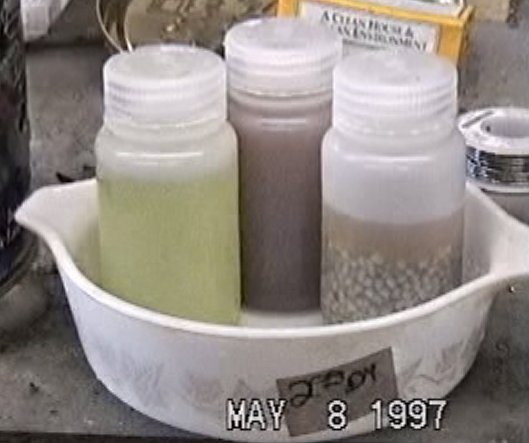
M-gold in left container m-rhodium and iridium in other two
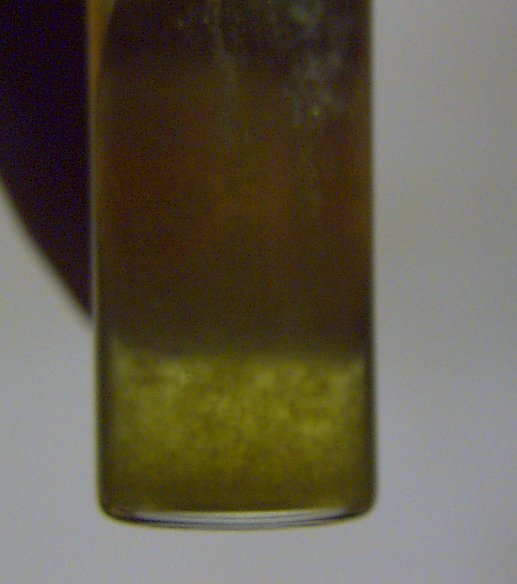
M-gold flocculent after slight agitation
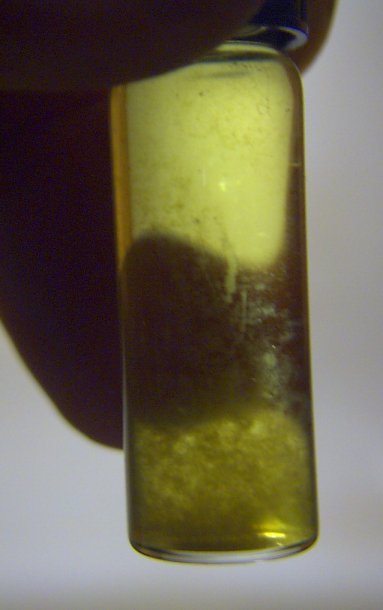
Another view of flocculent
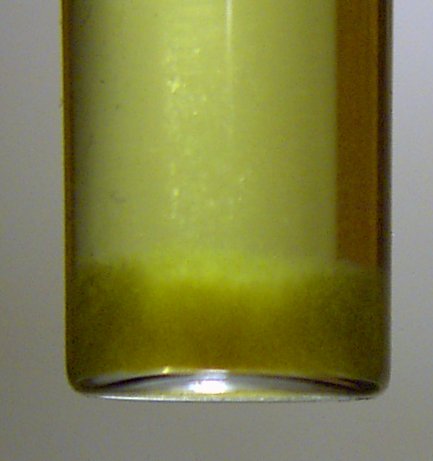
Before agitation
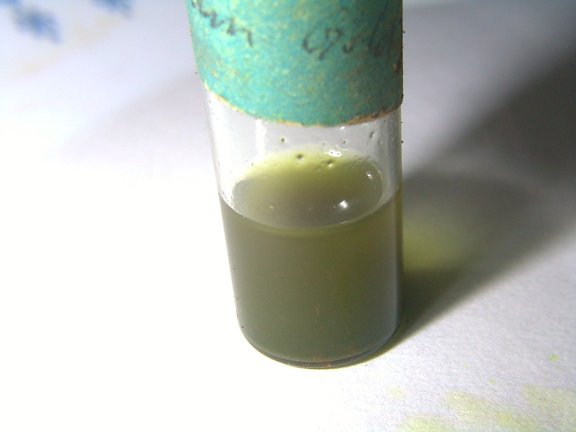
After thorough shaking up